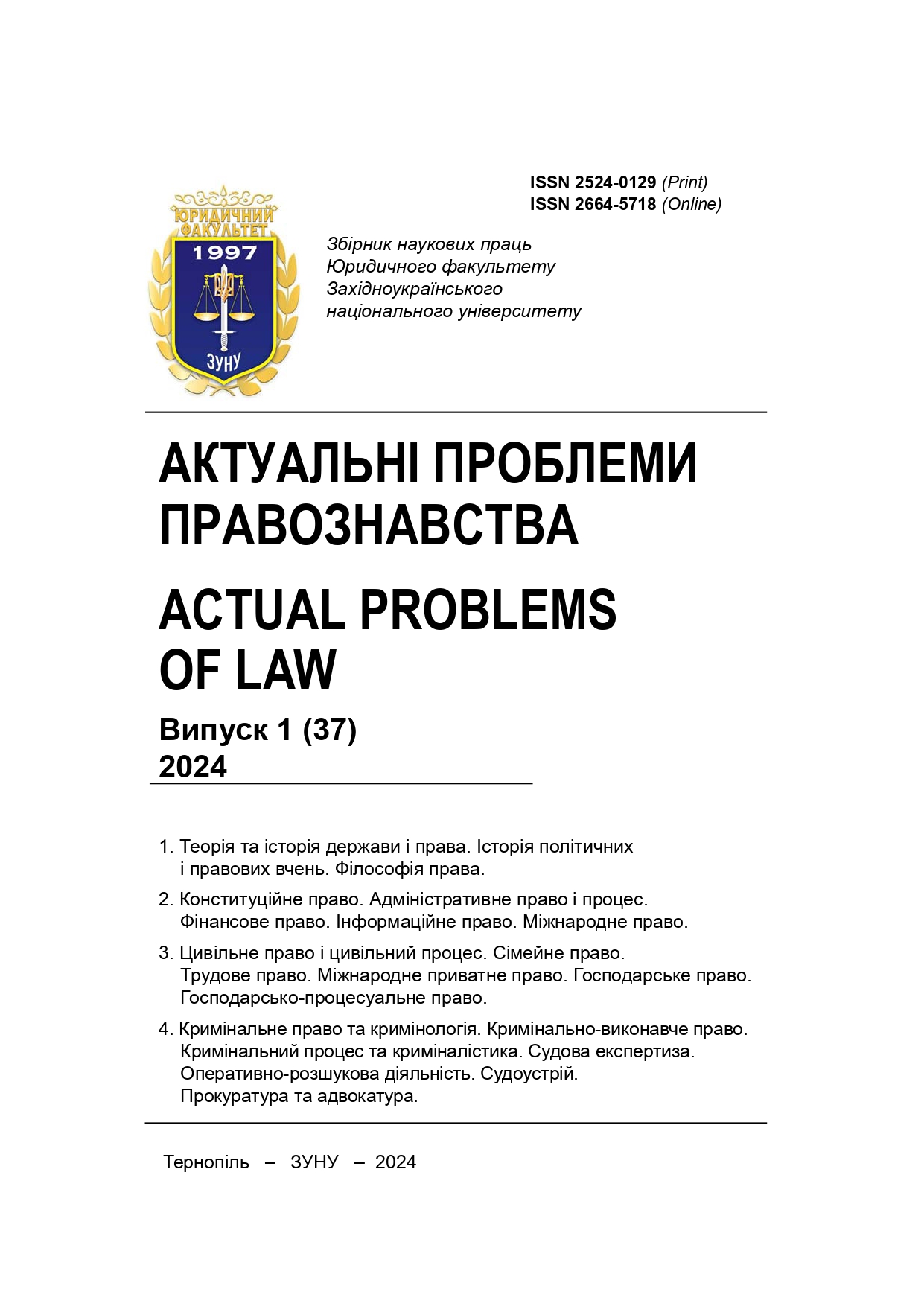The essence of law enforcement activity
DOI:
https://doi.org/10.35774/app2024.01.257Keywords:
law enforcement activity, public safety, law enforcement agencies, crime preventAbstract
The article examines the problems of the essence of law enforcement activity in the conditions of war in Ukraine, reveals various views of scientists on the definition of the studied concept. The author highlights the following main features of law enforcement activity: aimed at protecting the rights, rights, freedoms and legitimate interests of a person and ensuring law and order; implemented on the basis of the law with the help of legal measures provided for by law; are carried out by special state bodies or subjects authorized by the state (public formations, organizations, officials). The author divides law enforcement activities into the following types: protection of the order of social relations established by law - fight against offenders; public safety activities; fight against crime - disclosure and investigation of crimes; supervision of compliance with legislation; ensuring the execution of decisions of courts and other bodies in cases provided for by law; ensuring state policy in the field of justice; provision of qualified legal assistance to citizens and organizations, notarial activities, activities of private security and detective firms, etc. The structure of law enforcement agencies is considered. The article notes the researchers' opinion that law enforcement agencies cannot be demanded to eradicate and reduce crime. Their activities are only one of the factors that neutralize many aspects of crime. According to the author, public opinion is one of the main criteria for the official evaluation of the activities of law enforcement agencies, and in particular the Military Law and Order Service in the Armed Forces of Ukraine. It is determined by public trust and citizen support for the activities of law enforcement agencies. Therefore, in order to increase public trust and support their activities, law enforcement agencies should more actively involve citizens and public associations in law enforcement activities. On the basis of the conducted legal analysis, reasonable conclusions were made.
References
Bonyak, V. (2015). Orhany okhorony pravoporiadku Ukrainy v suchasnomu vymiri: konstytutsiino-pravovyi aspekt [Law enforcement bodies of Ukraine in the modern dimension: constitutional and legal aspect]: monohrafiia. Dnipropetrovsk: Lira [in Ukrainian]
Hrytsenko, V. G. (2017). Stanovlennia ta rozvytok pravookhoronnoi systemy Ukrainy: istoryko-pravovyi henezys [Formation and development of the law enforcement system of Ukraine: historical and legal genesis]. Naukovyi visnyk Mizhnarodnoho humanitarnoho universytetu. Seriia: Yurysprudentsiia – Scientific Bulletin of the International Humanitarian University. Series: Jurisprudence 25, 22-25 [in Ukrainian]
Kovaliv, M. V. & Drozdova, I. V. (2016). Diialnist Viiskovoi sluzhby pravoporiadku v Zbroinykh Sylakh Ukrainy [Activities of the Military Service of Law and Order in the Armed Forces of Ukraine]. Naukovyi visnyk Lvivskoho derzhavnoho universytetu vnutrishnikh sprav. Seriia yurydychna – Scientific Bulletin of the Lviv State University of Internal Affairs. Legal series, 2, 208-216 [in Ukrainian]
Kolomiets, V. (2019). Pravovi osnovy, zavdannia ta pryntsypy diialnosti Viiskovoi sluzhby pravoporiadku v Zbroinykh Sylakh Ukrainy [Legal foundations, tasks and principles of activity of the Military Service of Law and Order in the Armed Forces of Ukraine]. Aktualni problemy pravoznavstva – Actual problems of jurisprudence, 4, 252-258 [in Ukrainian]
Rudenko, M. V. & Shaituro, O. P. (2017). Shchodo vyznachennia poniattia «orhany pravoporiadku» [Regarding the definition of the concept of «law enforcement agencies»]. Visnyk Kharkivskoho natsionalnoho universytetu im. V. N. Karazina: Seriia «Pravo» – Bulletin of Kharkiv National University named after V. N. Karazina: «Law» series], 23, 158-160 [in Ukrainian]
Sokolenko, O. L. (2012). Status i mistse pravookhoronnykh orhaniv sered subiektiv pravookhoronnoi diialnosti [Status and place of law enforcement agencies among subjects of law enforcement activity]. Naukovyi visnyk Dnipropetrovskoho derzhavnoho universytetu vnutrishnikh sprav – Scientific Bulletin of the Dnipropetrovsk State University of Internal Affairs, 4, 246-254 [in Ukrainian]
Hamula, P. (2015). Osoblyvosti stanovlennia ta rozvytku pravookhoronnykh orhaniv na terytorii Ukrainy: istorychnyi aspekt [Peculiarities of the establishment and development of law enforcement agencies in the territory of Ukraine: historical aspect]. Viche - Viche, 4, 28-31 [in Ukrainian]
Hridochkin, V. A. (2019). - Shchodo zmistu poniattia «pravookhoronni orhany». [Regarding the meaning of the term «law enforcement agencies». Pravookhoronna funktsiia derzhavy: teoretyko-metodolohichni ta istoryko-pravovi problemy. Tezy dopovidei kruhloho stolu (m. Kharkiv, 27 zhovtnia 2017 r.) – Law enforcement function of the state: theoretical-methodological and historical-legal problems. Abstracts of the round table reports (Kharkov, October 27, 2017). Kharkiv, 244-246 [in Ukrainian]
Shoptenko, O. S. (2017). Systema pravookhoronnykh orhaniv Ukrainy [The system of law enforcement agencies of Ukraine]. Naukovyi visnyk publichnoho ta pryvatnoho prava – Scientific bulletin of public and private law, 3. P. 150-155. [in Ukrainian]
Yarmysh, N. (2016). Zmist termina «orhany pravoporiadku», vykorystanoho u statti 131-1 Konstytutsii Ukrainy [The content of the term «law enforcement agencies» used in Article 131-1 of the Constitution of Ukraine]. Bulletin of the National Academy of the Prosecutor's Office of Ukraine - Bulletin of the National Academy of the Prosecutor's Office of Ukraine, 4 (46), 79-84 [in Ukrainian]





